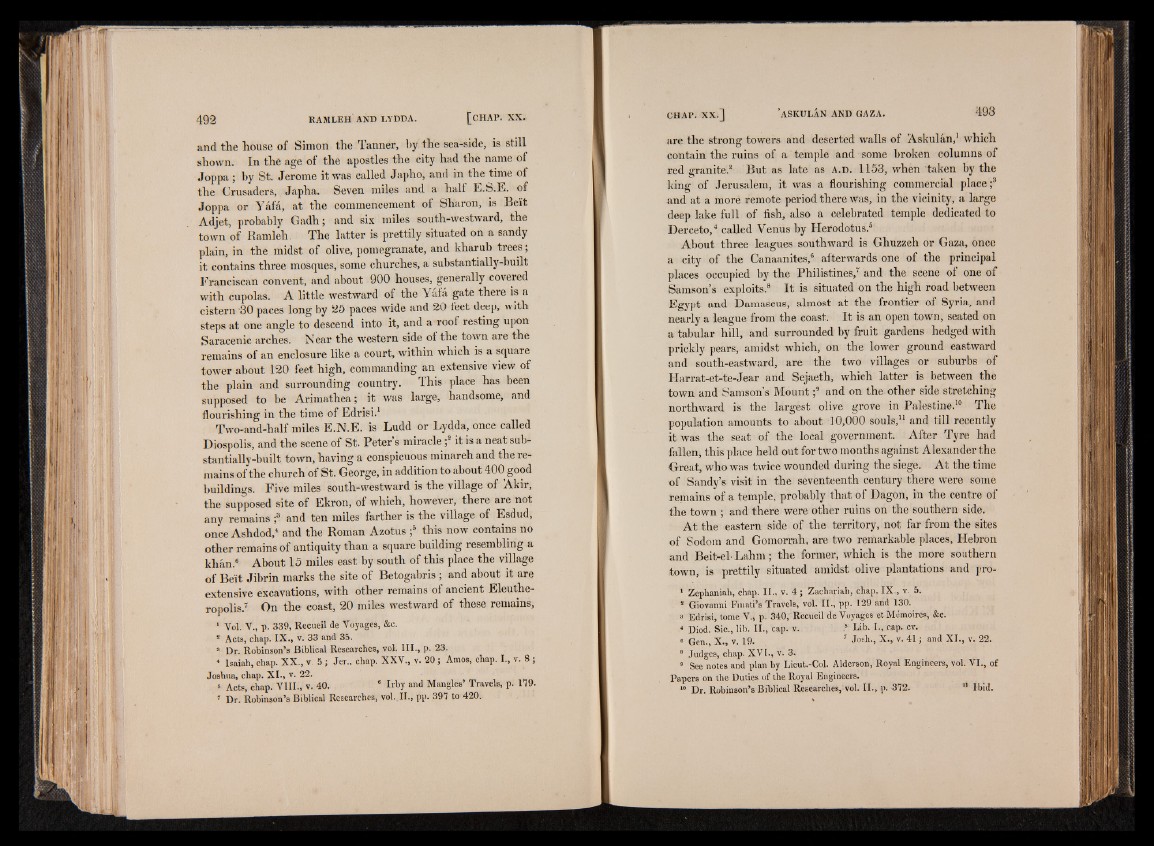
and the house of Simon the Tanner, by the sea-side, is still
shown. In the age of the apostles the city had the name of
Joppa ; by St. Jerome it was called Japho, and in the time of
the Crusaders, Japha. Seven miles and a half E.S.E. of
Joppa or Yafa, at the commencement of Sharon, is Beit
Adjet, probably Gadh; and six miles south-westward, the
town of Ramleh The latter is prettily situated on a sandy
plain, in the midst of olive, pomegranate, and kharub trees;
it contains three mosques, some churches, a substantially-built
Franciscan convent, and about 900 houses, generally covered
with cupolas. A little westward of the Yafa gate there is a
cistern 30 paces long by 25 paces wide and 20 leet deep, with
steps at one angle to descend into it, and a roof resting upon
Saracenic arches. Near the western side of the town are the
remains of an enclosure like a court, within which is a square
tower about 120 feet high, commanding an extensive view of
the plain and surrounding country. This place has been
supposed to be Arimathea; it was large, handsome, and
flourishing in the time of Edrisi.1
Two-and-half miles E.N.E. is Ludd or Lydda, once called
Diospolis, and the scene of St. Peter’s miracle ;s it is a neat substantially
built town, having a conspicuous minareh and the remains
of the church of St. George, in addition to about 400 good
buildings. Five miles south-westward is the village of Akir,
the supposed site of Ekron, of which, however, there are not
any remains ;3 and ten miles farther is the village of Esdud,
once Ashdod,4 and the Roman Azotus ;5 this now contains no
other remains of antiquity than a square building resembling a
khan.6 About 15 miles east by south of this place the village
of Beit Jibrin marks the site of Betogabris; and about it are
extensive excavations, with other remains of ancient Eleuthe-
ropolis.7 On the coast, 20 miles westward of these remains,
* Vol. V., p. 339, Recueil de Voyages, &c.
2 Acts, chap. IX., v. 33 and 35.
3 Dr. Robinson’s Biblical Researches, vol. III., p. 23.
4 Isaiah, chap. XX., v. 5 ; Jer., chap. XXV., v. 2 0 ; Amos, chap. I., v. 8 ;
Joshua, chap. XI., v. 22.
5 Acts, chap. VIII., v. 40. 6 Irby and Mangles’ Travels, p. 179.
7 Dr. Robinson’s Biblical Researches, vol..II., pp. 397 to 420.
are the strong towers and deserted walls of Askulân,1 which
contain the ruins of a temple and some broken columns of
red granite.2 But as late as A.D. 1153, when taken by the
king of Jerusalem, it was a flourishing commercial place;3
and at a more remote period there Was, in the vicinity, a large
deep lake full of fish, also a celebrated temple dedicated to
Derceto,4 called Venus by Herodotus.5
About three leagues southward is Ghuzzeh or Gaza, once
a city of the Canaanites,6 afterwards one of the principal
places occupied by the Philistines,7 and the scene of one of
Samson’s exploits.8 It is situated on the high road between
Egypt and Damascus, almost at the frontier of Syria, and
nearly a league from the coast. It is an open town, seated on
a tabular hill, and surrounded by fruit gardens hedged with
prickly pears, amidst which, on the lower ground eastward
and south-eastward, are the two villages or suburbs of
Harrat-et-te-Jear and Sejaeth, which latter is between the
town and Samson’s Mount ;9 and on the other side stretching
northward is the largest olive grove in Palestine.10 The
population amounts to about 10,000 souls,11 and till recently
it was the seat of the local government. After Tyre had
fallen, this place held out for two months against Alexander the
Great, who was twice wounded during the siege. At the time
of Sandy’s visit in the seventeenth century there were some
remains of a temple, probably that of Dagon, in the Centre of
the town ; and there were other ruins on the southern side.
At the eastern side of the territory, not far from the sites
of Sodom and Gomorrah, are two remarkable places, Hebron
and Beit-el-Lahm ; the former, which is the more southern
town, is prettily situated amidst olive plantations and pro-
1 Zephaniah, chap. II., v. 4 ; Zachariah, chap. IX., v. 5.
8 Giovanni Finati’s Travels, vol. II., pp. 129 and 130.
3 Edrisi, tome V., p. 340, Recueil de Voyages et Mémoires, &c.
4 Diod. Sic., lib. II., cap. v. . s Lib. I., cap. cv.
s Gen., X., v. 19. 7 Josh., X., v. 41 ; and XI., v. 22.
8 Judges, chap. XVI., v. 3.
8 See notes and plan by Lieut.-Col. Alderson, Royal Engineers, vol. VI., of
Papers on the Duties of the Royal Engineers.
10 Dr. Robinson’s Biblical Researches,-vol. II., p. 372. 11 Ibid.